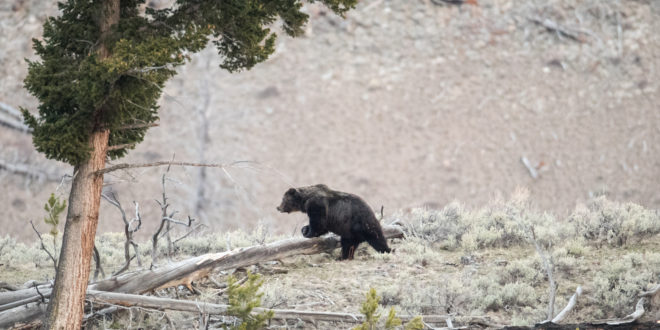A ruling on delisting Yellowstone grizzlies from the Endangered Species List could come in June, according to officials.
The news comes nearly two years after then-U.S. Fish and Wildlife Service director Dan Ashe penned a letter to Montana, Wyoming, and Idaho officials signaling the agency’s belief that Yellowstone grizzly bears no longer needed ESA protections—and months after the USFWS delayed their decision.
According to the Missoulian, part of the delay has been political in nature; most wildlife and park agencies still don’t have any appointed directors:
“It’s still hanging somewhere,” said Chris Servheen, who retired last year as the Interagency Grizzly Bear Committee’s recovery coordinator. “It’s very unusual to have change of administration and all this time with nobody knowing what’s going on. The Fish and Wildlife Service, BLM (Bureau of Land Management), National Park Service — nobody’s got any directors. And if this gets politically directed instead of following the biological decision, things are going to go south.”
The lack of an appointed agency director would not affect progress on the delisting effort, said Gavin Shire, U.S. Fish and Wildlife Service chief of Public Affairs.
“We can produce a rule with an acting director,” Shire said. “Jim Kurth, who was one of our two deputy directors, has assumed the role of acting director as of January 20. We’re still hoping for publication (of a final rule) this spring or early summer.”
[…]
“The (U.S.) Fish and Wildlife Service indicated the rule could be published as soon as June,” said Frank Van Manan, the wildlife biologist supervising the Interagency Grizzly Bear Study Team in Bozeman. “I’m not aware of any particular issue that would cause a specific delay.”
The USFWS delayed their decision, in part, to read the thousands of comments submitted under the comment period. Indeed, interest was so high the agency had to reopen comments a second time.
This isn’t the first time officials have looked at delisting Yellowstone grizzlies. They were previously taken off the list in 2007 but reinstated in 2009 when a district court judge ruled the agency had not adequately considered how declining whitebark pine would impact grizzly populations. The Ninth Circuit U.S. Court of Appeals ruled in 2011 the USFWS’ initial plan adequately addressed how to conserve bears. A new food source analysis was published in 2013.
State wildlife officials contend it’s time to take the reins on management, citing concerns of increased human-bear encounters, which prove deadly for both actors. Beyond management, the states are also interested in trophy hunting. Many officials, including Servheen, have been recalcitrant toward maintaining grizzly protections, especially when they were restored in 2009.
Opponents to the delisting rule, including advocates like Doug Peacock and former IGBST researchers like David Mattson, meanwhile, contend that climate change will exacerbate grizzly food shortages; opponents also fear state-level hunting would prevent Yellowstone grizzlies from reconnecting with other grizzly populations across the Rocky Mountain West, which advocates say is integral to the grizzly’s future.
Various Native American tribes have made special appeals against delisting, citing the bear’s importance to both their individual histories and collective culture. Indeed, several tribes signed a treaty in opposition to any delisting rule for Yellowstone grizzlies.
Some, including Yellowstone Superintendent Dan Wenk, have criticized the methodology used to estimate grizzly numbers. Wenk has also voiced concern with how state management would impact Yellowstone’s grizzly population. He made the sole (in person) nay vote at the Interagency Grizzly Bear Committee’s sub-meeting last November, saying grizzly hunting would have a deleterious impact on the region’s tourist industry.
IGBST teams are still penning grizzlies around Yellowstone. According to the Missoulian, grizzly work goes on irrespective of any formal rule change:
“There hasn’t been any huge change in our scientific operations,” Interagency Grizzly Bear Study Team spokeswoman Suzanna Soileau said. “Our main goal remains to look for reproductive-age females, because they’re the key to our population studies. We’re trying to see the demographic changes as they are moving to the edges of the ecosystem.”
Counting grizzly bears is the most important and controversial part of the conservation strategies. Whether the number grows or shrinks determines how much protection the bears need. Delisting from the Endangered Species Act could allow the surrounding states to offer hunting seasons on grizzlies. That would add a new threat to grizzly survival. The other threats are declining food sources, limited habitat, getting hit by cars, shot in self-defense incidents and killed by wildlife managers after getting into livestock or human food supplies.
The Missoulian adds that grizzlies in the Northern Continental Divide Ecosystem (near Glacier National Park and the Blackfeet Reservation) are, according to Montana FWP bear manager Cecilly Costello, “nowhere near a place on the delisting rule.”
 Yellowstone Insider Your Complete Guide to America's First National Park
Yellowstone Insider Your Complete Guide to America's First National Park





